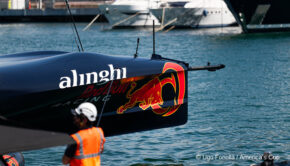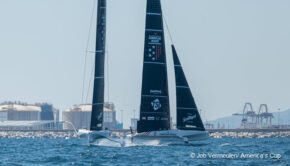Iain Murray, AC’s Cool Head In The Hot Seat
Published on August 20th, 2013
By Michelle Slade
It’s hard to say if Iain Murray, America’s Cup Race Management’s quietly spoken head honcho, will be pleased to see the end of AC34, or whether he almost wishes he could have it over again to make serious amends to a sailing event that has proven to be unpredictable.
At this stage of the game, with racing well underway, AC34 Regatta Director Iain Murray’s role is mostly about the racing. On race days, he’s at the Media Center first thing to give the morning media brief, then he’s off to the race committee boat to begin the day’s work—the real work.
On shore this past weekend record visitors checked into both the AC Village at San Francisco’s Marina Green, as well as at the America’s Cup Park at Pier 27, to witness the first races of the Louis Vuitton Cup Final. It was busy, the sun was shining, the beer flowed, people were happy. But out on the racecourse was another matter. It was back to one-boat-racing as both challengers incurred equipment breakages during the only two races sailed, and no racing as the breeze barely snuck up into the prescribed wind limit. The net result was Races 3 and 4 postponed until Monday. Here Murray explains how he is dealing with the daily frustrations of AC34.
How are you managing to juggle all the curveballs that must consume you on a daily basis?
IM: [Laughs] It’s just what I have to do. It’s my job to keep this show running. I’ve got a lot of good people helping me and there’s a lot of experience in the race management team. The America’s Cup has always been difficult, I think going forward it’s no less difficult. There’s been a lot of difficult instances in the past, whether it’s been wing-keels, or plastic yachts.
Is this what you expected two years ago?
IM: No, I can’t say it’s turned out quite how I expected. I think with all the action and bits and pieces, responsibility and liability has taken on a whole new level that I don’t think anyone could have anticipated.
Do you think that’s a result of having the event in San Francisco?
IM: Certainly San Francisco, it’s a beautiful looking bay standing on the shore, but you go out there and it’s a rugged piece of water. There’s a lot of current, it’s cold and it’s windy. It’s not as pretty as the postcards—it’s a challenging piece of water and it needs respect. I think that takes a bit of getting used to. It’s a bit of trap, you can sit here on Pier 27 basking in the sun and then go around the corner and get hammered.
With so many disappointments and almost-daily disasters, what has been the most challenging of these and how have you dealt with it?
IM: Clearly the loss of Bart [Andrew Simpson] has been the most difficult part of this Cup for everyone, it was just devastating for Artemis and obviously just devastating for friends and family of Bart. But, it’s also been devastating for the event. It’s dominated from May 9 to the end of July, and here we are in the Louis Vuitton finals and we’re really only getting back to where we hoped we’d be at the beginning with proper races and the focus on sailing.
I think it’s time that’s required to heal a lot of the tragedy in a way, and it’s hard to short-cut time. In the America’s Cup you always run out of time. You get to the end, and there are always people saying, “We should have done this, or that, what if we’d done that differently?” I get the sense that people are moving on, and certainly Artemis getting back on the water was a big part of that.
Where and how did things start going wrong in your opinion with this event?
IM: It’s easy to sit here now, look back and say, “We should have done this or that.” I think probably the biggest disappointment to people is the fact that we’re so short on challengers, and you can ask yourself why is that so? Clearly the cost of the campaign is an issue, the complexity of the campaign is another issue. I think everyone looking forward is saying, “These boats are really cool, the guys love sailing them, we’re in the first generation of boats foiling and understanding the race formats.”
We came off something that was pretty good at the end with the AC45s and high expectations with 10 boats roaring around, a great event in Naples, great events here in San Francisco, and Newport [R.I.]. In many ways coming back to three boats has been a dip. If you look back, you can say we need more controls, we needed something more like an AC45, something that was maybe not an AC72, but not an AC45. Maybe we should have done it in an AC45—I don’t know. I think a 55- to 60-foot semi one-design boat is probably what you’ll see the teams looking toward.
Do you think the event will stay with a multihull?
IM: People watching them love them, the guys sailing them love them. I just think it needs to be a lot less complicated [laughs].
I believe in November 2011 teams were given a choice to move forward with the 72, or go to another boat. A unanimous decision was required, and two teams—Artemis and ETNZ—chose not to. Can you comment?
IM: I put all the principals of the teams together in San Diego in 2011 and did ask them that question. It was clear by that time in the year what it was we were doing, and because there were challenges in the financial world post 2008 that the money wasn’t flying like it was in 2006-‘07. Getting teams to be able to step up from the ACWS to the America’s Cup was a lot more difficult than people had anticipated. The options were there and discussed. People had made commitments to designs and were well down the path of the 72 and the decision was to continue.
What did you think of that at the time?
IM: My job is to service the customers, and the customers are all the teams. This was a democratic process, and it was mutually agreed on most parts of what we are doing. In hindsight maybe we should have been stronger and taken the hard pulls early.
How do you keep your personal relationships—and respect—for people intact after some of the incidents that have gone down, for example, Luna Rossa’s refusal to sail?
IM: I think I was hired because they know I’m pretty focused and have a relatively tempered and logical view on most things with a lot of experience in all aspects of yachting, whether it is design, race management, event management, or whatever. I think people respect where I’ve come from and what I’ve done over the years. Generally, if I say something, I’ll be respected for the reason I said it. I don’t really get a lot of pressure to change my opinion. I try to be consistent and try to work with my team to put up the right conclusions for everyone. I haven’t had any real personal issues with any of the teams. There’s not “no talking” with anyone.
The Luna Rossa issue was a big deal, and I was really hurt. I’ve really had nothing to do with Luna Rossa in the past so the people who were making those accusations were generally people I didn’t know. Having said that, I did sell Mr. Bertelli my 12-Metres back in 2001, and I’ve designed some keels and rudders for him. I’ve had a good relationship with him for 12 years. We share a love for the old 12-Metres. I respect what he’s doing, and he respects what I’m doing. I’m not so sure that goes down the line with these guys …
People are tired of hearing, “It’s the America’s Cup, it’s always like this.” Do you think that’s a good enough excuse for the way things are?
IM: The thing is we have an event, we laid the foundations a long time ago, and it is what it is. Sure, we’ve had some accidents, etc., but if we’ve made mistakes in the foundations of this sporting event, this property, they were made at the beginning. I look back at what we’ve done, and I think there have been some tremendous things accomplished.
The 72s are very cool, but the racing is not compelling, particularly for sailing enthusiasts; how can this change?
IM: I think what’s on most people’s mind, and I’ve spoken to most of the teams, I think people will be looking to pull it much more back toward the 45s, which is a large degree of one-design parts to ensure that the racing and the boats are much more similar, to substantially reduce the costs, which is another part, and of course to ensure that the quality of the boats is there when they go to race. I think what we’re seeing here is a large development thing because the 72s really, in hindsight, have arrived too late. All that was done for cost reasons, but it might have not worked the way it was meant to work.
What we are seeing now in the Finals is that people are starting to sail these boats pretty well. Yesterday we saw the Oracle boats out there, and we saw ETNZ drop in on them; they look to be sort of similar [he smiles]. We’ve seen great improvement from Luna Rossa, and we saw huge improvement from Artemis in the limited time they had. When you look back at all that, you have to see that people lost a lot of time, whether it was Oracle capsizing—for one reason or another—as happens in every America’s Cup—they run out of time.
There has to be a silver lining; what is it for this event?
IM: I think the fact that kids are switching on and wanting to be involved. If you look at all those kids on the ramp down at Marina Green with the big boats, there’s kids tuning into YouTube and modern media—all of a sudden sailing has got onto the wish list of kids’ sport. They want to be involved in it. Hopefully we can come out of it with heroes and good guys who kids want to aspire to, like it happened to me when I was a kid. How we communicate that to everyone—the great TV, the modern technology, the fact that we take you on board and people can understand what the racing is about—we’ve simplified our racing with the umpiring and the television system (LiveLine). It’s all about making our sport understandable to the general public. I think there’s been a huge win there. Interview








 We’ll keep your information safe.
We’ll keep your information safe.